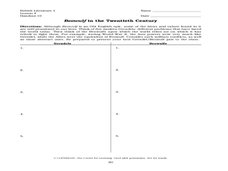Texas Education Agency (TEA)
How to Read and Analyze a Poem (English III Reading)
A poem is compressed speech, like a can of frozen juice with all the water pressed out. An interactive teaches users how to reconstitute the language, the structure, and the literary devices to appreciate all the subtleties the poet...
Wadsworth Atheneum Museum of Art
Where I'm From: Symbolism in Paint and Poetry
After a review of symbolism, class members use the provided worksheet to first list the objects they observe in Arnold Mesches' painting "Coney Island" and then suggest possible symbolic meanings for each of the objects. A second...
K20 LEARN
Memory Haiku: The Great Gatsby and the Sense of Smell
Scholars learn how smells evoke early childhood memories and apply that knowledge to a character from F. Scott Fitzgerald's The Great Gatsby. After finding a passage from the novel that references smells, they craft a haiku and a...
Curated OER
Shelley's Poems by Percy Bysshe Shelley
Challenge your class with these essay questions based on Percy Bysshe Shelley's poetry. This resource includes 3-8 short answer and essay questions for each of 9 different poems by Shelley. Pick and choose the poems you would like to...
National Endowment for the Humanities
“Every Day We Get More Illegal” by Juan Felipe Herrera
A study of Jan Felipe Herrera's poem "Every Day We Get More Illegal" opens the door for a discussion on immigration. To begin, class members examine the photograph "Desert Survival," record their observations of the image, and then...
Curated OER
Metaphor
High schoolers identify the distinction between literal and figurative language with a focus on metaphors. They complete a metaphor analysis chart, then practice expanding metaphors by composing their own comparisons of elements of the...
Curated OER
Patterns In Poetry: Images (Part 3)
Learners explore imagery in poetry. In this poetry lesson, students examine how the use of metaphors and similes aid in reading comprehension. Multiple resources are provided.
Curated OER
Kubla Khan Questions
In this reading comprehension worksheet, students respond to 5 short answer and essay questions based on the poem "Kubla Khan."
Curated OER
Could You Repeat That?
Students participate in an oral story telling activity designed to show how story embellishments occur. They read "Beowulf" and identify incongruities that suggest additions and embellishments over the years.
Schools United to Provide Enhanced Resources Network
AP English Project: Journal of Literary Terms and Devices
To prepare for the AP English exams, individuals are asked to create a notebook of literary terms and devices. The terms must be defined, accompanied by representative artwork, and illustrated by an example drawn for a named source. A...
Curated OER
The Concept of the Hero
Students explore the symbolic implications for the concept of the hero with a focus on the Beowulf theme. In this hero concept lesson, students find specific examples of monsters from Beowulf to complete the chart. Students list the...
Houghton Mifflin Harcourt
Les Miserables Study Help Essay Questions
In this literature worksheet, students respond to 20 short answer and essay questions about Hugo's Les Miserables. Students may also link to an online interactive quiz on the selection at the bottom of the page.
Other popular searches
- Shape Concrete Poetry
- Concrete Poetry 3rd Grade
- Concrete Poetry Activities
- Concrete Poetry Grades 5
- Teaching Concrete Poetry
- Writing Concrete Poetry
- Concrete Poetry Terms
- Concrete Poetry 5th Grade
- Concrete Poetry Stations
- Literacy Concrete Poetry
- Concrete Poetry Fourth Grade
- Concrete Poetry Form













